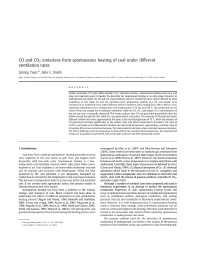Mining Publication: CO and CO2 Emissions from Spontaneous Heating of Coal Under Different Ventilation Rates
Original creation date: October 2011
Carbon monoxide (CO) and carbon dioxide (CO2) emissions during a spontaneous heating event in a coal mine are important gases to monitor for detecting the spontaneous heating at an early stage. However, in underground coal mines, the CO and CO2 concentrations and their related fire ratios may be affected by mine ventilation. In this study, CO and CO2 emissions from spontaneous heating of a U.S. coal sample were evaluated in an isothermal oven under different airflow ventilation rates ranging from 100 to 500 cm3/min. Laboratory experiments were conducted at oven temperatures of 70, 90, and 100 °C. The temperature at the center of the coal sample was continually monitored, while the CO, CO2, and oxygen (O2) concentrations of the exit gas were continually measured. The results indicate that CO was generated immediately after the airflow passed through the coal, while CO2 was generated in a late phase. The amounts of CO generated under different airflow rates were approximately the same at the initial temperature of 70 °C, while the amounts of CO generated increased significantly as the airflow rates and initial temperatures increased. The ratio of CO/CO2 was found to be independent of airflow rate and initial temperature, approaching a constant value of 0.2 quickly if there was no thermal runaway. The value tended to decrease when a thermal runaway took place. The CO/O2 deficiency ratio was dependent on both airflow rates and the initial temperature. The experimental results are in qualitative agreement with some large-scale test and field monitoring results.
Authors: L Yuan, AC Smith
Peer Reviewed Journal Article - October 2011
NIOSHTIC2 Number: 20039785
Int J Coal Geol 2011 Oct; 88(1):24-30
See Also
- CO Dispersion from a Coal Fire in a Mine Entry
- Coal-Mine Ventilation Factors
- Development and Application of Reservoir Models and Artificial Neural Networks for Optimizing Ventilation Air Requirements in Development Mining of Coal Seams
- Experimental and Modeling Investigation of the Effect of Ventilation on Smoke Rollback in a Mine Entry
- Field Study of Longwall Coal Mine Ventilation and Bleeder Performance
- Investigation into the Practical Use of Belt Air at US Longwall Operations
- Novel Stopping Designs for Large-Opening Metal/Nonmetal Mines
- Reservoir Modeling-Based Prediction and Optimization of Ventilation Requirements During Development Mining in Underground Coal Mines
- Technology News 519 - EZ-Up Curtain Stoppings: A Practical Solution for Directing Ventilation Airflows in Large-opening Metal/Nonmetal Mines
- Using Ultrasonic Anemometers to Evaluate Face Ventilation Conditions
- Content source: National Institute for Occupational Safety and Health, Mining Program


 ShareCompartir
ShareCompartir
